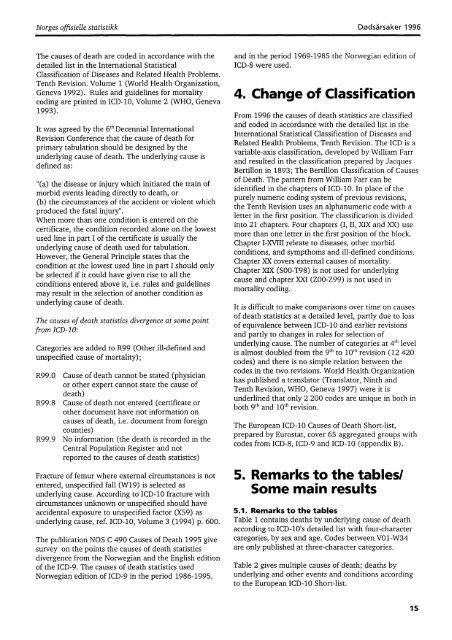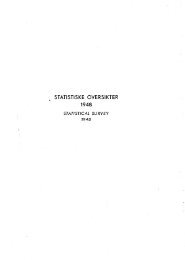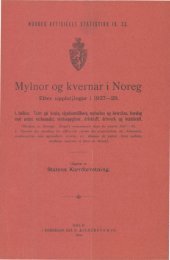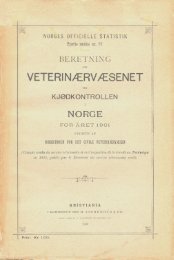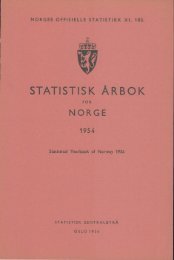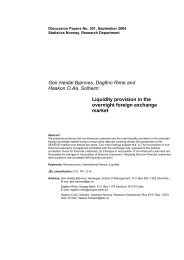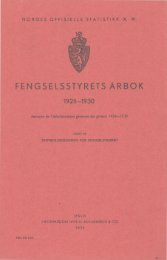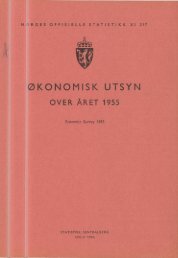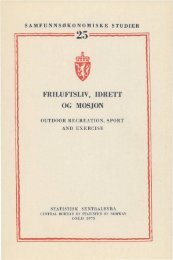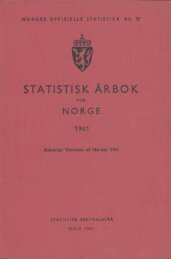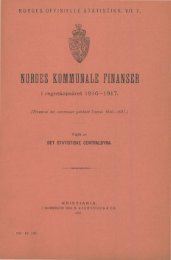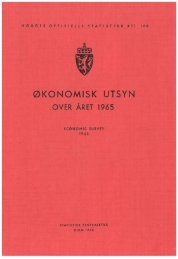Dødsårsaker 1996 - SSB
Dødsårsaker 1996 - SSB
Dødsårsaker 1996 - SSB
Create successful ePaper yourself
Turn your PDF publications into a flip-book with our unique Google optimized e-Paper software.
Norges offisielle statistikk Dødsårsaker <strong>1996</strong><br />
The causes of death are coded in accordance with the<br />
detailed list in the International Statistical<br />
Classification of Diseases and Related Health Problems.<br />
Tenth Revision. Volume 1 (World Health Organization,<br />
Geneva 1992). Rules and guidelines for mortality<br />
coding are printed in ICD-10, Volume 2 (WHO, Geneva<br />
1993).<br />
It was agreed by the 6th Decennial International<br />
Revision Conference that the cause of death for<br />
primary tabulation should be designed by the<br />
underlying cause of death. The underlying cause is<br />
defined as:<br />
"(a) the disease or injury which initiated the train of<br />
morbid events leading directly to death, or<br />
(b) the circumstances of the accident or violent which<br />
produced the fatal injury".<br />
When more than one condition is entered on the<br />
certificate, the condition recorded alone on the lowest<br />
used line in part I of the certificate is usually the<br />
underlying cause of death used for tabulation.<br />
However, the General Principle states that the<br />
condition at the lowest used line in part I should only<br />
be selected if it could have given rise to all the<br />
conditions entered above it, i.e. rules and guidelines<br />
may result in the selection of another condition as<br />
underlying cause of death.<br />
The causes of death statistics divergence at some point<br />
from 1CD- 10 :<br />
Categories are added to R99 (Other ill-defined and<br />
unspecified cause of mortality);<br />
R99.0 Cause of death cannot be stated (physician<br />
or other expert cannot state the cause of<br />
death)<br />
R99.8 Cause of death not entered (certificate or<br />
other document have not information on<br />
causes of death, i.e. document from foreign<br />
counties)<br />
R99.9 No information (the death is recorded in the<br />
Central Population Register and not<br />
reported to the causes of death statistics)<br />
Fracture of femur where external circumstances is not<br />
entered, unspecified fall (W19) is selected as<br />
underlying cause. According to 1CD-10 fracture with<br />
circumstances unknown or unspecified should have<br />
accidental exposure to unspecified factor (X59) as<br />
underlying cause, ref. ICD-10, Volume 3 (1994) p. 600.<br />
The publication NOS C 490 Causes of Death 1995 give<br />
survey on the points the causes of death statistics<br />
divergence from the Norwegian and the English edition<br />
of the ICD-9. The causes of death statistics used<br />
Norwegian edition of ICD-9 in the period 1986-1995,<br />
and in the period 1969-1985 the Norwegian edition of<br />
1CD-8 were used.<br />
4. Change of Classification<br />
From <strong>1996</strong> the causes of death statistics are classified<br />
and coded in accordance with the detailed list in the<br />
International Statistical Classification of Diseases and<br />
Related Health Problems, Tenth Revision. The ICD is a<br />
variable-axis classification, developed by William Farr<br />
and resulted in the classification prepared by Jacques<br />
Bertillon in 1893; The Bertillon Classification of Causes<br />
of Death. The pattern from William Farr can be<br />
identified in the chapters of ICD-10. In place of the<br />
purely numeric coding system of previous revisions,<br />
the Tenth Revision uses an alphanumeric code with a<br />
letter in the first position. The classification is divided<br />
into 21 chapters. Four chapters (I, II, XIX and XX) use<br />
more than one letter in the first position of the block.<br />
Chapter I-XVIII releate to diseases, other morbid<br />
conditions, and sympthoms and ill-defined conditions.<br />
Chapter XX covers external causes of mortality.<br />
Chapter XIX (S00-T98) is not used for underlying<br />
cause and chapter XXI (Z00-Z99) is not used in<br />
mortality coding.<br />
It is difficult to make comparisons over time on causes<br />
of death statistics at a detailed level, partly due to loss<br />
of equivalence between 1CD-10 and earlier revisions<br />
and partly to changes in rules for selection of<br />
underlying cause. The number of categories at 4th level<br />
is almost doubled from the 9th to 10th revision (12 420<br />
codes) and there is no simple relation between the<br />
codes in the two revisions. World Health Organization<br />
has published a translator (Translator, Ninth and<br />
Tenth Revision, WHO, Geneva 1997) were it is<br />
underlined that only 2 200 codes are unique in both in<br />
both 9th and 10th revision.<br />
The European ICD-10 Causes of Death Short-list,<br />
prepared by Eurostat, cover 65 aggregated groups with<br />
codes from 1CD-8, ICD-9 and ICD-10 (appendix B).<br />
5. Remarks to the tables/<br />
Some main results<br />
5.1. Remarks to the tables<br />
Table 1 contains deaths by underlying cause of death<br />
according to ICD-10's detailed list with four-character<br />
categories, by sex and age. Codes between V01-W34<br />
are only published at three-character categories.<br />
Table 2 gives multiple causes of death; deaths by<br />
underlying and other events and conditions according<br />
to the European 1CD-10 Short-list.<br />
15


